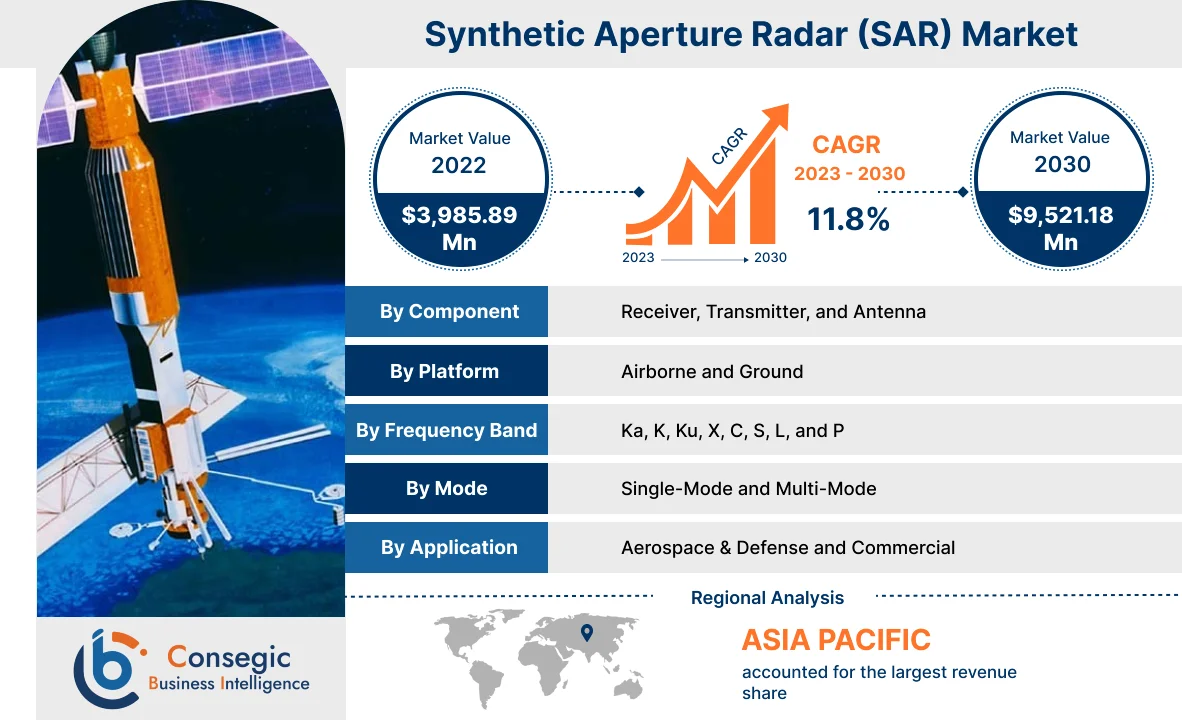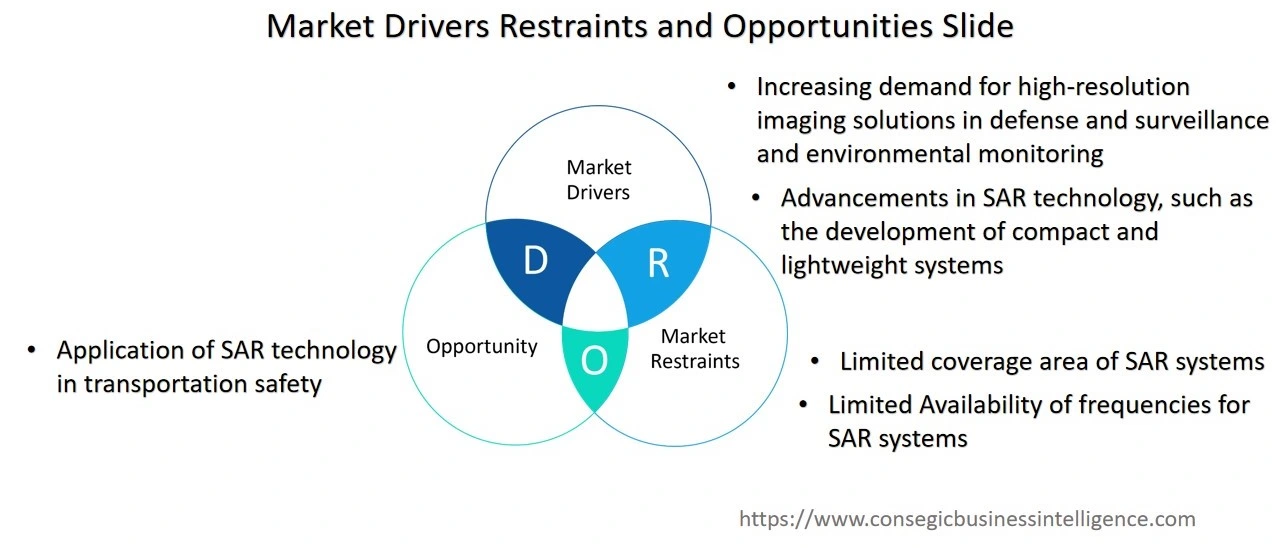Synthetic Aperture Radar (SAR) Market Size :
Synthetic Aperture Radar (SAR) Market is estimated to reach over USD 9,521.18 Million by 2030 from a value of USD 3,985.89 Million in 2022, growing at a CAGR of 11.8% from 2023 to 2030.
Synthetic Aperture Radar (SAR) Market Scope & Overview:
Synthetic Aperture Radar (SAR) is a remote sensing technology that uses radar to create images of the Earth's surface. SAR is a form of active remote sensing that emits its own energy source (microwave radiation) and detects the energy that is reflected back from the surface of the earth. The SAR technology is used for a wide range of applications, including monitoring changes in the earth's surface, mapping land use and land cover, detection of oil spills and other environmental hazards, and military reconnaissance.
Synthetic Aperture Radar (SAR) Market Insights :
Synthetic Aperture Radar (SAR) Market Dynamics - (DRO) :
Key Drivers :
Increasing demand for high-resolution imaging solutions in defense surveillance and environmental monitoring
The increasing demand for high-resolution imaging of the earth's surface for applications such as environmental monitoring, military surveillance, and mapping is driving the synthetic aperture radar market. SAR is used in disaster management to assess the extent of damage caused by natural disasters such as earthquakes, floods, and landslides. Moreover, SAR is used to detect and track objects on land and in water.
- For instance, in November 2022, Synspective and Global Change Research System (GCRS) announced a partnership to offer SAR satellite-based risk analysis solutions in South Asia. The partnership aims to provide critical information to governments, NGOs, and the private sector to manage risks associated with natural disasters, climate change, and other environmental hazards.
As a result, the growing need for security and surveillance is accelerating the synthetic aperture radar (SAR) market growth.
Advancements in SAR technology, such as the development of compact and lightweight systems
The development of new SAR technologies, such as compact and lightweight SAR systems, is driving the market. The development of lightweight and compact SAR is suitable for unmanned aerial vehicles and small satellites, thereby providing high-resolution imaging in a small form factor. Moreover, the application of polarimetric SAR provides additional information about the earth's surface, such as the type of terrain, the presence of vegetation, and the moisture content of the soil. As a result, PolSAR is used in a wide variety of applications such as forestry, agriculture, and urban planning.
- For instance, in November 2022, the United Nations (UN) announced the development of a high-tech, satellite-based global methane detection system in order to help countries and companies reduce methane emissions, a potent greenhouse gas that contributes significantly to climate change.
In conclusion, advancements in technology have led to significant improvements in SAR systems, enabling greater accuracy, efficiency, and effectiveness resulting in the synthetic aperture radar (SAR) market growth.
Key Restraints :
Limited coverage area of SAR systems
Synthetic Aperture Radar (SAR) systems, while powerful for earth observation and surveillance, face limitations in their coverage area due to the necessity for a clear line of sight to the earth's surface. SAR relies on the use of radio waves to generate images, and these waves can be obstructed by dense vegetation, buildings, or other geographical features, particularly in urban or forested regions. As a result, SAR systems have difficulty collecting accurate data in areas with significant obstructions. This limitation reduces the utility of SAR in specific regions, thus impeding the overall growth and adoption of SAR technology. Enhancing SAR systems to improve their penetration abilities and increase coverage in challenging environments is a key focus for advancing the synthetic aperture radar (SAR) market demand.
Limited Availability of frequencies for SAR systems
Another significant challenge for the SAR market is the limited availability of frequencies required for the operation of these systems. SAR technologies depend on specific frequency bands for transmitting and receiving signals, and these frequencies are often regulated and allocated by international bodies such as the International Telecommunication Union (ITU). With the increasing demand for wireless communication and satellite services, competition for frequency bands has intensified, creating bottlenecks for SAR systems. The constrained availability of suitable frequencies limits the operational capacity of SAR systems, hindering their widespread use, especially in commercial and defense sectors. Expanding frequency allocations or developing more frequency-efficient technologies could help mitigate this challenge and stimulate the synthetic aperture radar (SAR) market demand.
Future Opportunities :
Application of SAR technology in transportation safety
The application of SAR systems in transportation safety is expected to present potential opportunities for the growth of the market. SAR is expected to be used to monitor vessel traffic, track the movement of ships, and detect illegal activities such as smuggling and piracy. Moreover, SAR is expected to detect and track aircraft, providing real-time information on their location and movement. The information is used to improve safety in aviation, such as identifying potential collisions or monitoring unauthorized flights in restricted airspace. Furthermore, the application of SAR systems to monitor traffic congestion, accidents, and road conditions is expected to create significant synthetic aperture radar (SAR) market opportunities.
Synthetic Aperture Radar (SAR) Market Report Insights :
| Report Attributes | Report Details |
| Study Timeline | 2017-2030 |
| Market Size in 2030 (USD Billion) | USD 9,521.18 Million |
| CAGR (2023-2030) | 11.8% |
| Base Year | 2022 |
| By Component | Receiver, Transmitter, and Antenna |
| By Platform | Airborne and Ground |
| By Frequency Band | Ka, K, Ku, X, C, S, L, and P |
| By Mode | Single-Mode and Multi-Mode |
| By Application | Aerospace & Defense and Commercial |
| By Geography | Asia-Pacific, Europe, North America, South America, Middle East & Africa |
| Key Players | EarthDaily Analytics, Thales Group, SkyGeo, Saab AB, Raytheon Technologies Corporation, OHB System AG, Northrop Grumman, Lockheed Martin Corporation, Leonardo S.p.A, ICEYE, General Atomics, Cobham Limited, Capella Space, BAE Systems, Airbus S.A.S |
Synthetic Aperture Radar (SAR) Market Segmental Analysis :
By Component :
Based on the component, the market is trifurcated into receiver, transmitter, and antenna.
The antenna segment accounted for the largest revenue share of the total synthetic aperture radar (SAR) market share in the year 2022. The growing need for higher-resolution imaging and longer-range detection in applications such as defense, agriculture, forestry, and infrastructure monitoring is driving the antenna segment. The antenna is responsible for transmitting and receiving the microwave signals used by the SAR system to create high-resolution images of the target area. The antenna's performance determines the system's imaging capabilities, including the resolution, range, and accuracy of the images.
- For instance, in July 2022, Surrey Satellite Technology Limited (SSTL) and Oxford Space Systems (OSS) announced the completion of an advanced deployable synthetic aperture radar antenna payload.
Consequently, the development of innovative and advanced SAR antenna technology for earth observation applications is contributing to synthetic aperture radar (SAR) market trends.
The transmitter segment is expected to emerge as the fastest-growing segment during the forecast period. The advancements in transmitter technology, such as the development of digital-to-analog converters and high-power amplifiers are driving the segment. The transmitter is responsible for generating the microwave signals that are transmitted towards the target area. As a result, the segmental trends analysis shows that the development of new power amplifiers and digital-to-analog converters enables higher performance and efficiency, thereby driving the synthetic aperture radar (SAR) market expansion.
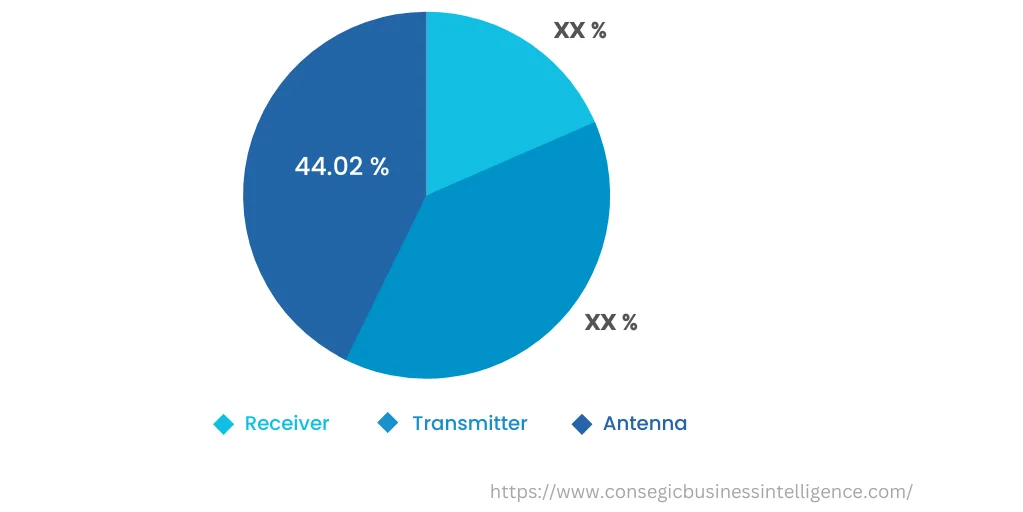
By Platform :
Based on the platform, the market is bifurcated into airborne and ground.
The airborne segment accounted for the largest revenue share of the overall synthetic aperture radar (SAR) market share in the year 2022. Airborne SAR systems offer high-resolution imaging capabilities that are essential for applications such as surveillance, mapping, and disaster monitoring. The high-resolution images provide detailed information about the target area to identify potential risks and take necessary actions. Airborne SAR systems are mounted on aircraft, drones, or satellites to provide high-resolution and wide coverage for applications such as environmental monitoring, agriculture, and defense.
- For instance, in September 2022, HENSOLDT launched new-generation solutions for radar surveillance and radar electronic support for wildlife protection as well as the protection of land.
Thus, analysis of segmental trends depicts that the ability of radar systems to detect potential risks on earth is accelerating the synthetic aperture radar (SAR) market trends.
The ground segment is expected to emerge as the fastest-growing segment during the forecast period. Ground-based SAR systems are installed on the ground and are used for various applications, including infrastructure monitoring, geological mapping, and mineral exploration. Ground-based SAR systems offer high-resolution imaging capabilities and operate over a range of frequencies to support different applications. Furthermore, the segmental trends show that the application of SAR data in commercial applications, such as monitoring of natural resources, agriculture, and infrastructure is contributing to the synthetic aperture radar (SAR) market opportunities.
By Frequency Band :
Based on the frequency band, the market is segregated into Ka, K, Ku, X, C, S, L, and P.
The X-band segment accounted for the largest revenue share in the year 2022. The X-band offers a good balance between imaging resolution and penetration capabilities suitable for a wide range of applications, including maritime surveillance, ground mapping, and disaster monitoring. Moreover, the X-band offers high-resolution imaging capabilities that are critical for military applications such as reconnaissance, surveillance, and target acquisition.
- For instance, in December 2021, MDA and ICEYE signed an agreement to integrate an X-band synthetic aperture radar satellite into MDA's CHORUS constellation to provide a new level of real-time insight and innovative Earth observation services.
Thus, the segmental trends analysis shows that the ability of X-band frequency to provide real-time information on Earth is driving the synthetic aperture radar (SAR) market expansion.
The Ku-band segment is expected to witness the fastest CAGR during the forecast period. The Ku-band is able to penetrate through clouds and foliage, making it ideal for applications that require imaging in adverse weather conditions or in areas with dense vegetation. Therefore, the Ku-band segment is well-suited for applications such as weather monitoring, disaster management, and urban planning. Moreover, the synthetic aperture radar (SAR) market analysis shows that the increasing availability of small and lightweight SAR systems for unmanned aerial vehicles and other small platforms is propelling the market.
By Mode :
Based on the mode, the market is divided into single-mode and multi-mode. The multi-mode SAR accounted for the largest revenue share in the year 2022. Multi-mode SAR systems are designed to operate at multiple frequencies, thereby supporting various imaging modes and applications such as environmental monitoring, disaster response, maritime surveillance, and military applications. Multi-mode SAR systems offer greater flexibility and versatility that are optimized for specific applications and operating frequencies. As a result, multi-mode SAR systems are used to track changes in vegetation and land use, monitor coastal areas, and detect oil spills. Furthermore, multi-mode SAR systems are used to detect and map damage caused by natural disasters such as earthquakes and floods.
- For instance, in September 2022, BAE Systems announced to launch multi-sensor satellite cluster into the Earth's orbit to provide military customers with high-quality information and intelligence in real-time from space.
Thus, the segmental trends analysis shows that the multi-mode SAR systems that support a wide variety of applications are accelerating the market.
By Application :
Based on the application, the market is segmented into aerospace & defense and commercial. The aerospace & defense industry accounted for the largest revenue share in the year 2022. The growing demand for advanced surveillance and observation capabilities in the defense industry is driving the growth of the synthetic aperture radar market. SAR technology allows for high-resolution imaging and real-time situational awareness, providing critical information to military and defense decision-makers. Moreover, the growing demand for unmanned aerial vehicles and autonomous systems is also driving the aerospace & defense segment of the market.
The commercial segment is expected to emerge as the fastest-growing segment during the forecast period. SAR technology supports a wide variety of commercial applications such as public safety, environment monitoring, day and night imaging, and terrain topography, thereby driving the market.
- For instance, in February 2022, Spacety launched two new satellites into orbit, namely the Chaohu-1 SAR satellite and the Thor smart satellite to capture high-resolution images of the earth's surface for disaster monitoring, environmental protection, and resource management applications.
Thus, the synthetic aperture radar (SAR) market analysis shows that the aforementioned applications require high-resolution imaging and real-time data to enable effective decision-making, resulting in increased demand for synthetic aperture radar applications.
By Region :
The regional segment includes North America, Europe, Asia Pacific, the Middle East and Africa, and Latin America.
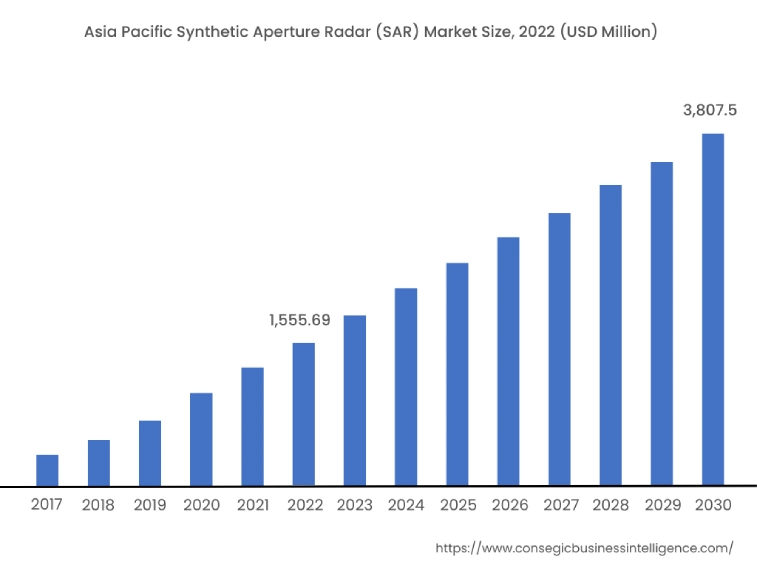
The Asia-Pacific region accounted for the largest revenue share valued at USD 1555.69 million in the year 2022 and is estimated to grow with a CAGR of 12.1% during 2023-2030. In Asia Pacific, China accounted for the maximum revenue share of 28.8% during the same year. The increasing demand for high-resolution imagery for applications such as urban planning, land-use mapping, and natural resource management is driving the SAR market in the Asia Pacific region. SAR technology is capable of providing high-resolution images with better accuracy and coverage, further resulting in market growth. Thus, the regional trends analysis shows that the increasing demand for high-resolution images along with government initiatives is propelling the growth of the market.
North America is expected to register the fastest CAGR of 11.3% during the forecast period. North America has a well-established aerospace and defense industry that uses SAR technology for surveillance, reconnaissance, and intelligence-gathering purposes. Moreover, North America has a well-established infrastructure for satellite-based communication and navigation systems that supports the growth of the SAR market in the region.
- For instance, in May 2021, Officials of the U.S. Air Force Research Laboratory announced a USD 5.2 million contract to the BAE Systems Electronic Systems for the Moving Target Recognition (MTR) project.
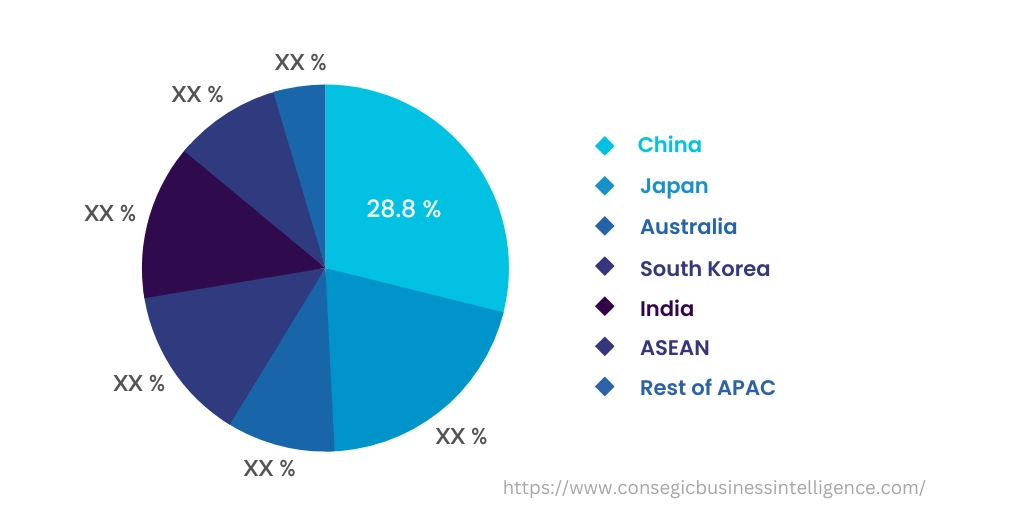
Top Key Players & Market Share Insights:
The synthetic aperture radar market’s competitive landscape has been thoroughly analyzed in the report which includes detailed profiles of major players in the industry. The market's growth has been further accelerated by increased Research and Development (R&D), product innovation, various business strategies, and the launch of new applications.
- Airbus
- BAE Systems
- Capella Space
- Cobham Limited
- EarthDaily Analytics
- General Atomics
- ICEYE
- Leonardo S.p.A
- Lockheed Martin Corporation
- Northrop Grumman
- OHB System AG
- Raytheon Technologies Corporation
- Saab AB
- SkyGeo
- Thales Group
Recent Industry Developments :
- In January 2022, ICEYE launched its fifteenth and sixteenth synthetic aperture radar (SAR) satellites into orbit, including the first satellite built, licensed, and operated by ICEYE US.
- In March 2023, the NASA-ISRO Synthetic Aperture Radar (NISAR) mission payload featuring 40 40-foot radar antenna is transported to India to observe the planet's land every 12 days.
Key Questions Answered in the Report
What is Synthetic Aperture Radar (SAR)? +
Synthetic Aperture Radar (SAR) is a remote sensing technology that uses the motion of the radar antenna to create a high-resolution image of the ground or other targets. SAR technology is useful for imaging areas that are difficult to access, such as forests, mountains, and polar regions for detecting changes in the earths surface caused by natural or human-made factors.
What are some of the most important applications of Synthetic Aperture Radar (SAR) and how do they impact the industrys growth potential? +
SAR technology is used for earth observation, including environmental monitoring, land cover mapping, and change detection. SAR images provide detailed information on soil moisture, vegetation, and other environmental variables. Moreover, SAR is used for disaster management, including flood mapping, earthquake and landslide detection, and monitoring of oil spills and other environmental disasters.
What insights are covered by the factors driving the growth of the Synthetic Aperture Radar (SAR) market, as well as the opportunities and challenges that may impact the markets future development? +
The increasing demand for high-resolution imaging solutions in various applications such as defense and surveillance, environmental monitoring, agriculture, and infrastructure monitoring is accelerating the growth of the market. Moreover, the application of SAR technology in transportation safety presents significant growth opportunities for the SAR market. However, the limited coverage area of SAR systems to provide a clear sight of the earths surface is hindering the growth of the market.
Based on current market trends and future predictions, which geographical region will have the largest impact on the SAR markets growth in the coming years? +
North America is expected to witness fastest CAGR growth in the coming years. North American region has a well-established defense industry, and the demand for SAR technology in the defense sector is increasing due to the need for advanced situational awareness and intelligence gathering capabilities. Additionally, SAR technology is being increasingly used for border surveillance and coastal monitoring in North America.
